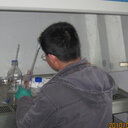Mutational analysis revealed that conservation of hepatitis B virus reverse transcriptase residue 306 (rtP306) is crucial for encapsidation of pregenomic RNA.
Palavras-chave
Resumo
Hepatitis B virus (HBV) is a DNA virus which replicates via reverse transcription. The structure and function of the reverse transcriptase play important roles in HBV replication. We have previously reported that when proline at residue 306 in HBV reverse transcriptase was substituted by other amino acids, most of the mutants showed decreased replicative competency. To explore the mechanisms for this decrease in replicative competency, constructs with substituted amino acid residues at rtP306 were used to transfect Huh-7 cells, and replication competencies, transcription levels and encapsidation efficiencies of the mutants and the parental viral strain were compared. Decreased replication competency was found with many of the mutants and confirmed by trans-complementation between each mutant and a replication-defective replicon. No change in transcriptional level was detected between all mutated constructs. The encapsidation competencies of these constructs were studied by assaying pregenomic RNAs in intracytoplamic core particles from transfected cells, which were normalized for the amount of HBV core protein by Western blotting using anti-core antibodies. Impaired encapsidation was found in several mutants substituted at residue 306, thereby demonstrating for the first time that conservation of proline at this residue is crucial for efficient encapsidation of pregenomic RNA.



